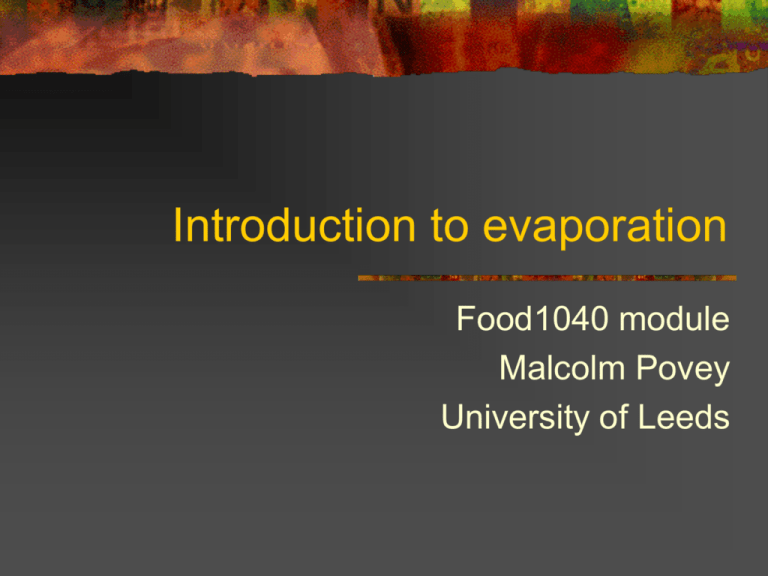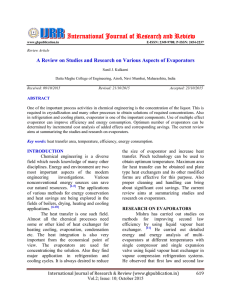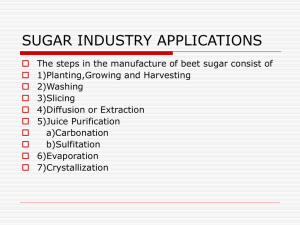Introduction to evaporation
advertisement

Introduction to evaporation Food1040 module Malcolm Povey University of Leeds Evaporator basics The liquid feed moves on the "hot" inner walls in an evaporator. Heat is continuously transferred from the outside of the wall to the inside, thereby heating up the liquid to the boiling point where water evaporates from the liquid feed. http://www.apv.com/anhydro/evapo/anhevap.htm Liquid distribution One of the most important issues influencing the effectiveness of the evaporation is the distribution of the liquid on the inner walls. To make the evaporation effective the liquid film on the inner walls should be as thin as possible. However, if the film is too thin, the product will burn on the walls, therefore it is very important to be able to control the thickness of the film also known as "the wetting rate". http://www.apv.com/anhydro/evapo/anhevap.htm Typical applications Milk and milk products Sweetened condensed milk WPC35, WPC60 and WPC80 Whey and whey permeate Fruit juice (tropical, citrus, temperate) Coffee, tea Sugar (different types) Vitamins, pharmaceuticals Various teas and herb extracts More applications Various proteins e.g. blood or gelatine Various broths e.g. chicken beef Bulk chemicals Waste water: Spent waste water (distilleries) •General waste water The principles of evaporation The product to be concentrated is separated from the heating medium by a tube wall, or a flat curved plate. The typical heating medium is steam or vapour. The system can be evacuated in order to lower the boiling temperature. The evaporated vapour can be reused as heating medium often in combination with either mechanical or thermal recompression. (Regeneration) The laboratory CFE Heat and mass transfer are connected Heat transfer in a CFE q ~(θs - θp) More specifically :Equation 1 q = U.A. (θs - θp) = U.A. Δθ Where A U θs θp = heat exchange area = 0.251 m2 steaminlet steamoutlet = overall heat transfer coefficient 2 = average steam temperature in the calandria jacket = product temperature at boiling point (boiling set point) Energy consumption As evaporation is a very energy consuming process, the availability and relative cost of energy determine the design of the evaporation plant. Normally an evaporation plant is designed to use the energy as efficiently as possible by using more than one effect. Therefore the following technical solutions are used in order to keep the temperature of the steam high enough to run the process: Optimising energy use •Thermal Vapour Recompression (TVR) •Mechanical Vapour Recompression (MVR) or •combination of both Shown below is a figure illustrating the relation between the number of effects and energy consumption under standard conditions for a typical product. Furthermore, the figure also shows a rough correlation between steam and electrical energy consumption per kg water evaporated, allowing the customer to estimate, whether the price of electric power in his local area justifies the use of MVR instead of TVR. Comparison http://www.apv.com/anhydro/evapo/anhevap.htm Evaporator pictures and applications Single effect recompression •Corn Syrup •Gelatin •Salt •Soybean Oil •Steepwater •Sugar •Whey Falling Film Plate & Tubular Evaporators The unique liquid distribution •Short residence time •Low temperature difference with •Single pass operation •Even shorter residence time •Larger capacities Typical applications are: •Milk, whey and milk products •Fruit juices , Various vitamins , Pharmaceuticals •Essence recovery Falling film evaporator http://www.swensonequip.com/vrml.html Rising/Falling Film Plate Evaporators •The unique liquid distribution •Short residence time •Low temperature difference Typical applications are: •Milk, whey and milk products •Fruit juices •Various vitamins •Pharmaceuticals •Essence recovery Rising Film Plate Evaporators APV´s rising film plate evaporators (Paravap) are particularly effective in processing high viscous liquids. Typical applications are: •High viscous sugar •Fruit puree and pulp •High viscous pharmaceuticals •Polymers Other evaporators http://www.swenson-equip.com/index.html Forced circulation evaporator Evaporator Diagrams Falling film evaporator Forced Convection with steam jet recompression Multiple effect evaporator Wiped Film Evaporator











